Best Platforms for Hosting Virtual Job Board Events
Virtual job board events are transforming how job seekers and employers connect, offering flexible, interactive spaces for career fairs, networking, and hiring. Choosing the right platform is key to ensuring smooth operations and engagement. Here’s a quick summary of what matters most:
-
Core Features to Look For:
- Live Video & Chat: High-quality video, breakout rooms, and Q&A tools for seamless communication.
- Custom Spaces: Branded booths, layouts, and downloadable resources for professional appeal.
- Payment Tools: Stripe integration, tiered pricing, and automated invoicing for monetization.
- Analytics & Matchmaking: AI-powered suggestions and engagement tracking to optimize outcomes.
- Mobile & Accessibility: Full functionality on smartphones, multi-language support, and ADA-compliant features.
-
Top Platforms:
- Job Boardly: A no-code platform with Stripe integration, custom job categories, and SEO tools.
- vFairs: Known for interactive virtual booths and support for large-scale events.
- Premier Virtual: Focused on replicating in-person job fairs with an intuitive interface.
- CareerEco: Built for virtual recruiting with advanced communication tools and sponsorship options.
- Success Tips: Promote early, use matchmaking tools, and track analytics to measure engagement and improve future events.
Quick Comparison:
| Platform | Key Features | Best For | Pricing Range |
|---|---|---|---|
| Job Boardly | Custom spaces, Stripe integration, SEO | Monetized niche job boards | Custom pricing |
| vFairs | Virtual booths, multi-time zone support | Large-scale events | $8,000-$80,000 |
| Premier Virtual | In-person feel, easy-to-use interface | Small to mid-sized events | Custom pricing |
| CareerEco | Advanced tools, sponsorship options | Virtual recruiting | $325-$1,000+ |
Focus on your event size, budget, and audience needs when selecting a platform to ensure a smooth and engaging experience.
Virtual Job Fair Software Demos
What to Look for in Virtual Job Board Event Platforms
Picking the right platform for virtual job board events is all about finding features that keep attendees engaged while ensuring everything runs smoothly. The best platforms strike a balance between technical reliability and ease of use, creating a hassle-free experience for job seekers, employers, and event organizers.
Live Video and Chat Features
Good communication tools are the backbone of any successful virtual event. High-quality video streaming is essential for hosting webinars, panel discussions, and one-on-one interviews. The platform should handle multiple video sessions at the same time without sacrificing audio or visual quality, even during busy periods.
Breakout rooms, group chats, and moderated Q&A sessions are must-haves. These features help recreate the organic networking moments you'd find at in-person events, giving job seekers the chance to interact directly with employers and ask questions.
Screen sharing is another critical tool. Employers can use it to showcase presentations, demonstrate software, or guide candidates through application processes. A platform should support these features seamlessly, regardless of the device or internet speed participants are using.
Custom Event Spaces
A branded virtual environment can make all the difference in creating a professional and engaging experience. Look for platforms that allow organizers to customize layouts and virtual booths with company logos, color schemes, promotional materials, and downloadable resources like job descriptions or application forms. Some platforms even offer creative layouts, from traditional booths to casual lounge areas for networking.
Navigation in these spaces should be straightforward. Clear visual cues and search functions help participants efficiently find opportunities and connect with the right employers.
Payment Tools and Stripe Integration
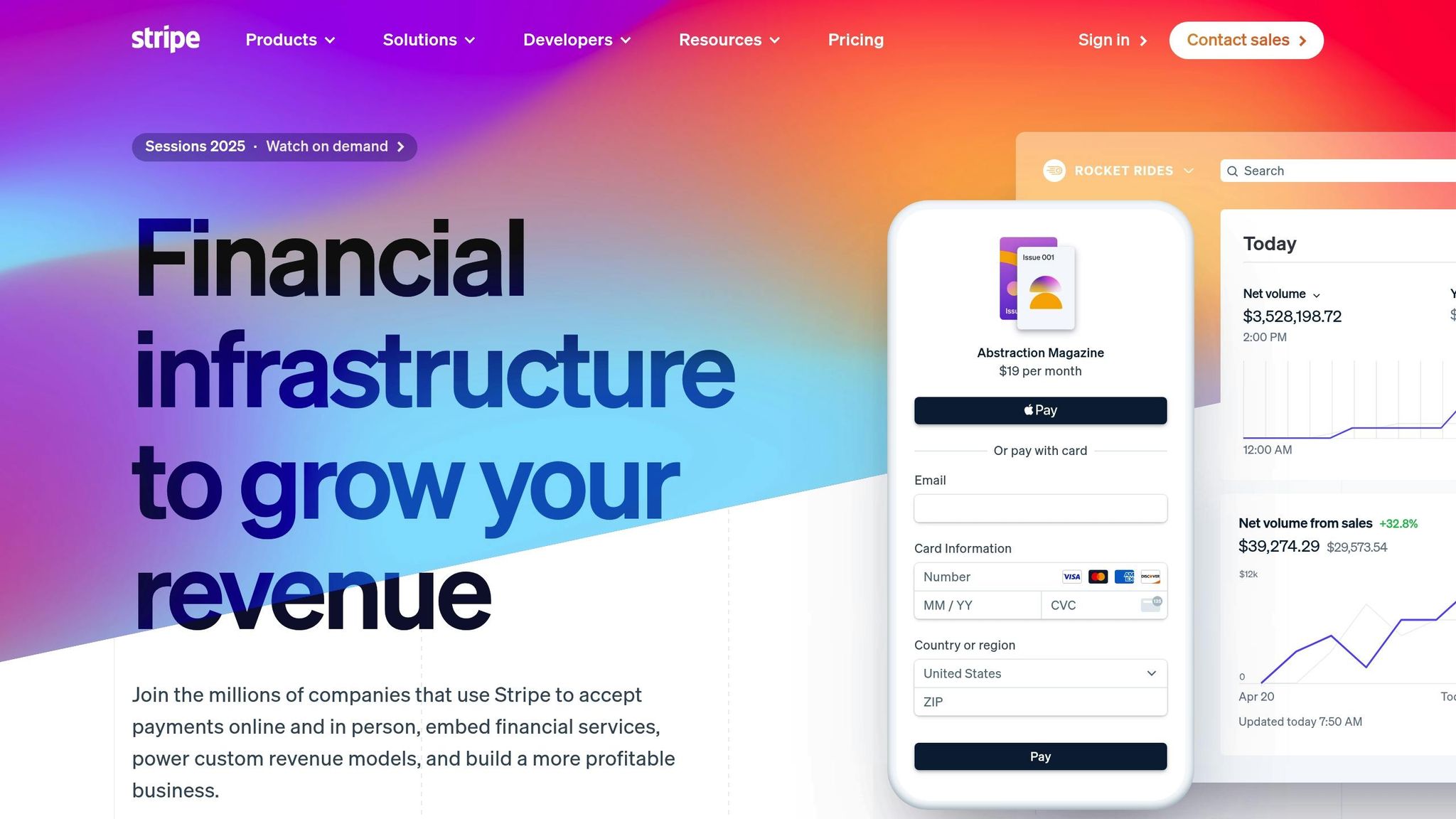
If you're monetizing your event, the platform needs to support flexible pricing options like free registration with premium upgrades, tiered ticket pricing, or employer booth fees. Integration with Stripe is a big plus, as it ensures secure payment processing that aligns with U.S. financial standards and provides a familiar checkout experience.
Paywalls can also be useful for offering different access levels, such as basic entry versus premium networking or exclusive employer meetings. The platform should handle tasks like invoicing, payment confirmations, and refunds automatically. Bonus points if it integrates with accounting software to simplify financial tracking.
Analytics and Matchmaking Features
Data can turn a good event into a great one. Robust analytics tools should track attendee engagement, session attendance, popular employers, and connections made. This information helps organizers fine-tune future events and proves the event's value to participating companies.
Matchmaking features powered by AI are another game-changer. By analyzing participant profiles, job preferences, and employer requirements, the platform can suggest relevant connections, saving time for both job seekers and recruiters.
Real-time reporting is handy during the event, allowing organizers to address issues or highlight popular areas as they arise. After the event, detailed analytics can provide insights into participant behavior, successful matches, and overall engagement.
Mobile Support and Accessibility
With so many people relying on smartphones and tablets, mobile optimization is non-negotiable. A platform should maintain full functionality across devices, ensuring smooth video, chat, and navigation experiences no matter the screen size.
Multi-language support can help broaden the event's reach, especially in diverse job markets or areas with significant bilingual populations. Accessibility features like screen reader compatibility, keyboard navigation, closed captioning, and adjustable text sizes ensure everyone can participate fully. These features not only meet ADA standards but also reflect a commitment to inclusive hiring.
Finally, the platform should offer flexibility, like automatically adjusting video quality based on internet speed and allowing offline access to downloaded materials. This ensures a consistent experience for all users, no matter their technical setup.
Job Boardly: Complete Platform for Virtual Job Board Events
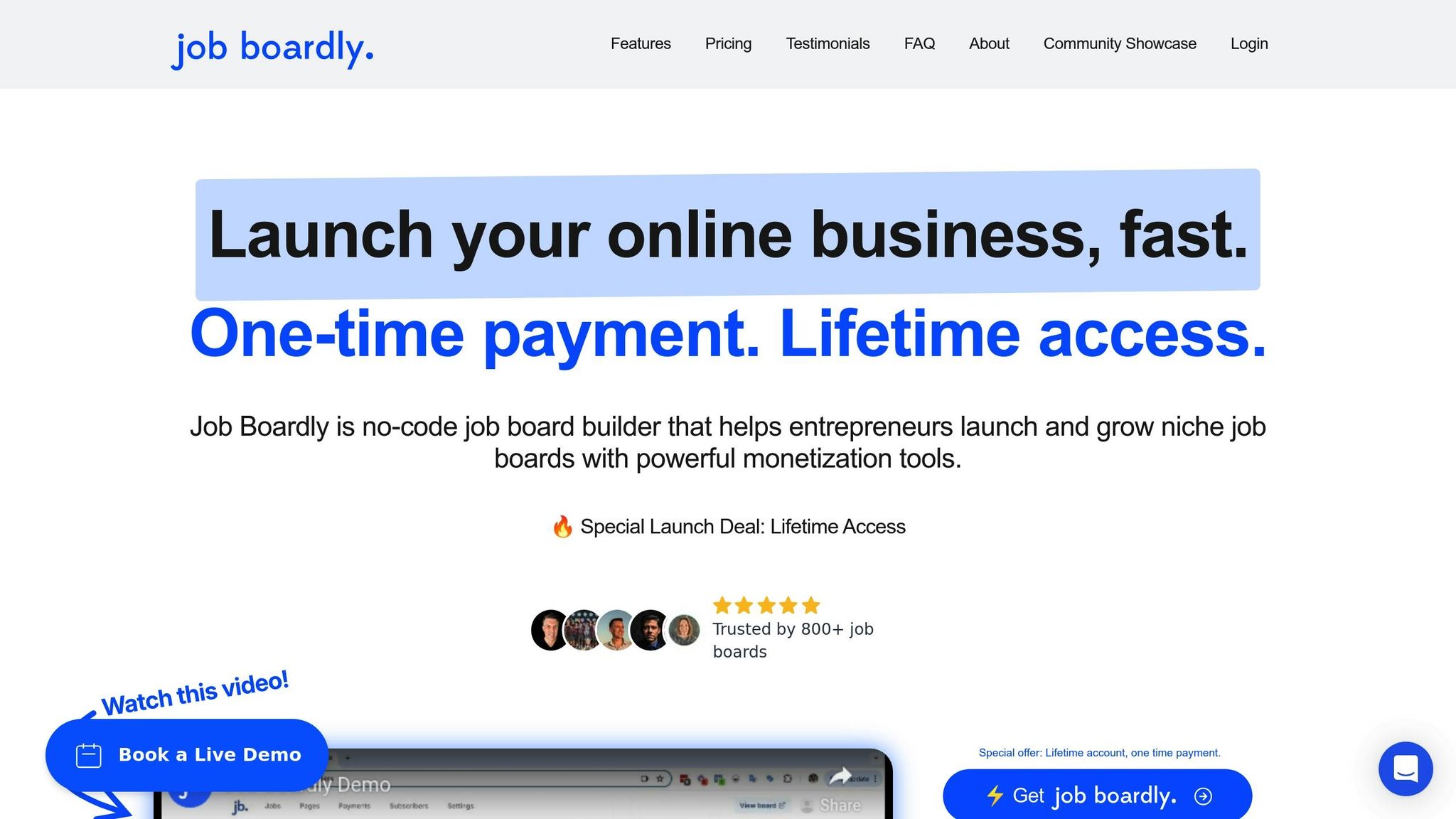
Job Boardly brings together all the tools needed to create, manage, and monetize niche job boards in one easy-to-use platform. Designed as a no-code solution, it’s tailored for U.S. event organizers who want to host virtual job board events without worrying about technical complications. Fully hosted and ready to go, Job Boardly allows organizers to focus on building connections and fostering community engagement.
With its powerful monetization tools, Job Boardly empowers organizers to run profitable virtual events while keeping their attention on the participants. The platform’s seamless Stripe integration ensures secure payment processing in U.S. dollars, making it simple to handle transactions for both employers and job seekers. This opens up various revenue opportunities, from premium job postings to exclusive access packages.
Custom Job Categories and Pages
Job Boardly stands out with its ability to create custom job categories and dedicated pages, making it perfect for targeted events. Organizers can easily segment their boards by industry, job role, or experience level, all while using branded pages that are optimized for search engines.
Beyond categorization, the platform allows organizers to design branded virtual spaces that reflect their organization’s identity. Custom color schemes, logos, and promotional materials can be added to make each event feel unique. Each job category can feature its own landing page with specialized filters, helping participants quickly find the opportunities most relevant to them.
The platform’s built-in SEO tools are another major advantage. These tools help boost the visibility of job board pages, driving organic traffic and attracting more candidates and employers. This is especially useful for niche boards targeting specific industries or regions in the U.S.
Payment Processing and Stripe Integration
Job Boardly’s Stripe integration makes handling payments straightforward and secure. Organizers can choose from a variety of monetization models, including one-time registration fees, tiered pricing, pay-per-job-posting for employers, or subscription-based access for ongoing events.
The platform also supports coupon codes and promotional pricing, making it easy to offer discounts like early-bird rates, group pricing, or even complimentary access for select participants. This flexibility helps organizers cater to different audience needs while meeting their revenue goals.
Mobile-Friendly and Multi-Language Support
With most U.S. job seekers accessing job boards via mobile devices, Job Boardly’s responsive design ensures a smooth experience across all screen sizes. Whether participants are browsing on a smartphone or tablet, the platform adjusts its layout and navigation to maintain usability.
For events targeting diverse or global audiences, Job Boardly offers multi-language support. This feature is particularly helpful in U.S. cities with large bilingual populations or for events focusing on international remote work. Organizers can localize their job board pages to make them more accessible and inclusive for non-English speakers.
Real-Time Analytics for Better Insights
Job Boardly also comes equipped with analytics tools that provide valuable insights into user behavior. Organizers can track data like job views, application rates, employer engagement, and revenue generation. These metrics enable event hosts to understand their audience better and make informed decisions for future improvements. By analyzing this data, organizers can refine their strategies to create even more engaging and successful events.
With its range of features, Job Boardly takes care of everything a virtual job board event needs - making it a practical and efficient choice for U.S. event organizers.
sbb-itb-316a34c
Best Platforms for Virtual Job Board Events
When it comes to hosting virtual career events, several platforms stand out for their ability to create engaging and interactive experiences tailored to job board communities. Here’s a closer look at some of the top options.
vFairs
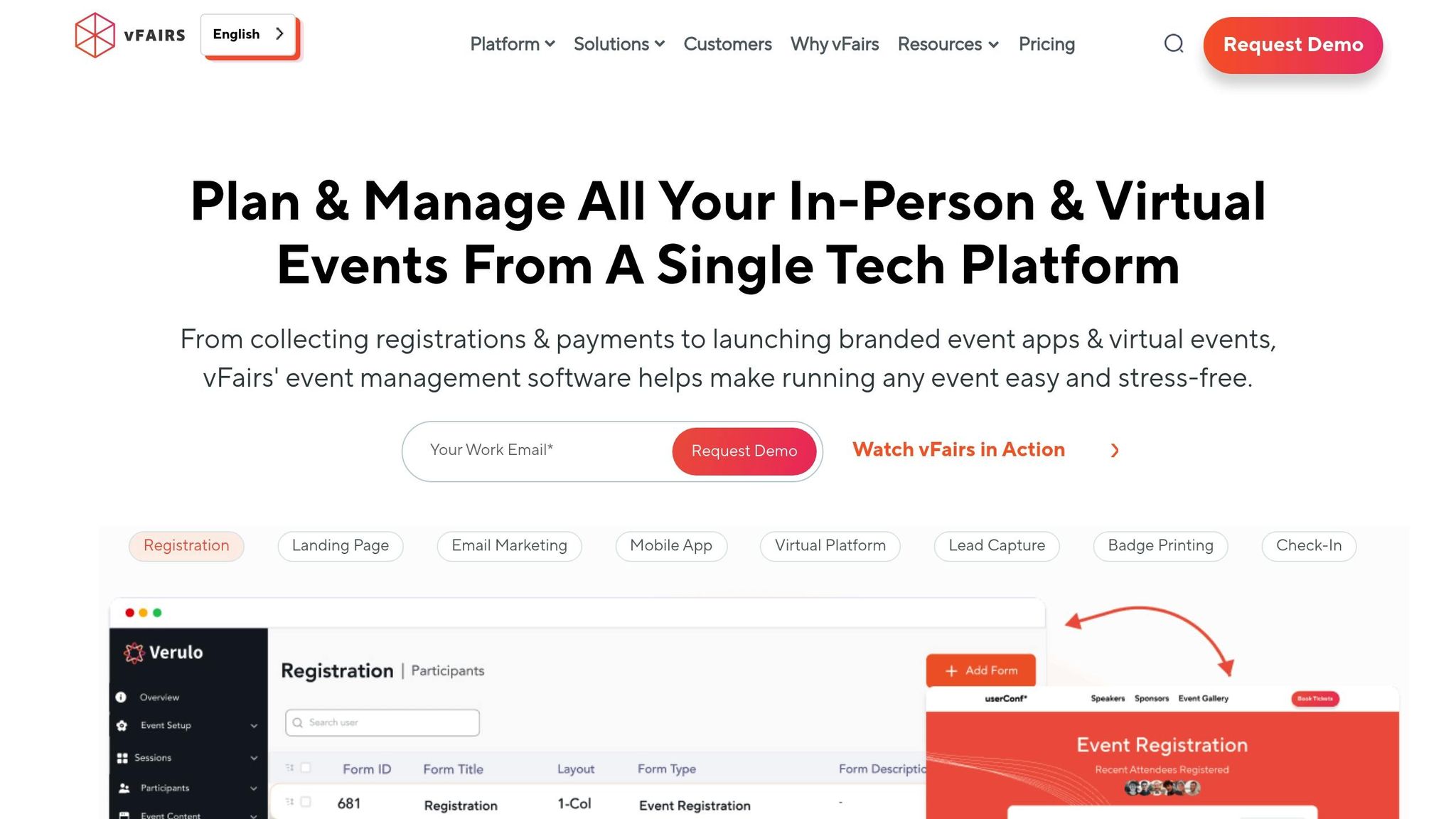
vFairs creates a dynamic virtual environment where employers can connect with job seekers through interactive features like virtual booths. These booths allow companies to highlight their culture and career opportunities in an engaging way. The platform is built to handle large-scale events across multiple time zones, offering a seamless experience for participants nationwide. For those looking for an alternative with a similar emphasis on interactivity, Premier Virtual brings its own strengths to the table.
Premier Virtual
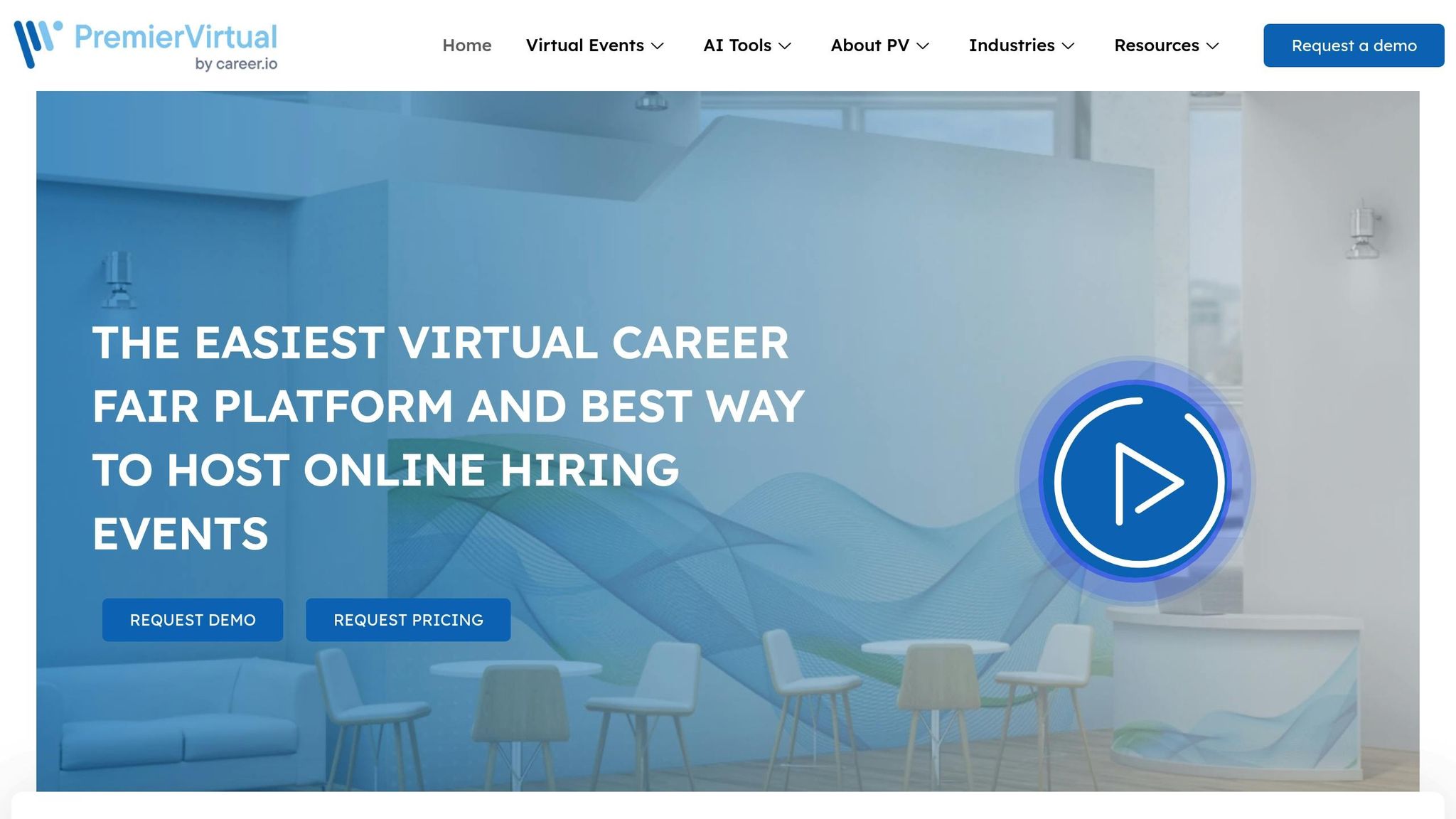
Premier Virtual is designed to simulate the feel of an in-person job fair, making it a great choice for organizations shifting to online events. Its intuitive interface ensures participants require little to no training, making the transition smooth for everyone involved. For example, a school district using Premier Virtual reported a 50% jump in attendance. The platform also provides detailed analytics and data management tools, giving organizers valuable insights into attendee engagement and event success. For a platform with a different focus, CareerEco offers a unique alternative.
CareerEco
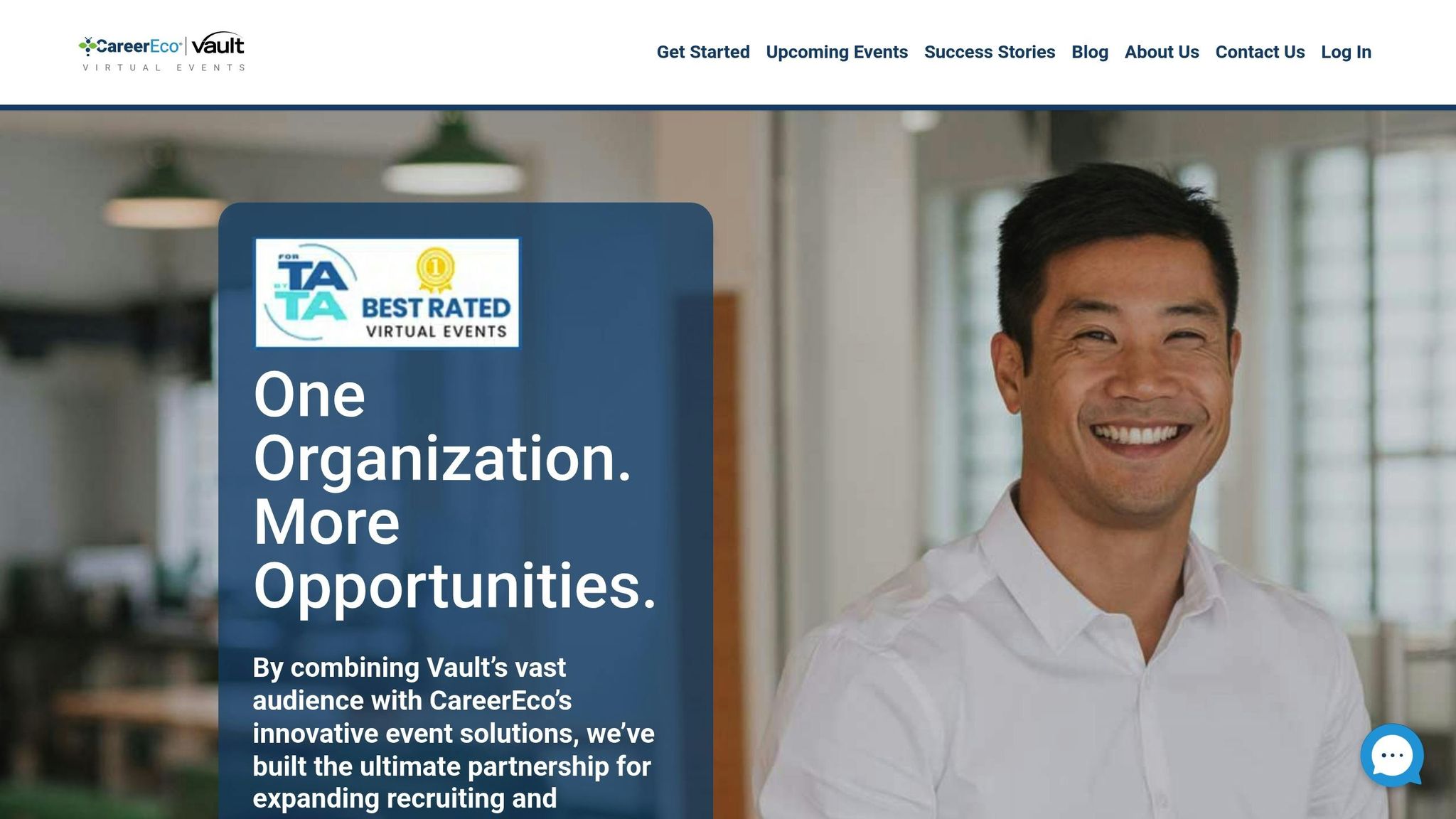
With over 15 years of experience, CareerEco specializes in breaking down geographical barriers for virtual recruiting. Its advanced communication tools and data management features make it a strong contender for hosting virtual career events. Pricing includes registration fees ranging from $325 (early-bird) to $625 (late non-members), while sponsorship packages are available at $650 (Bronze), $750 (Silver), and $1,000 (Gold).
How to Run Successful Virtual Job Board Events
Pulling off a successful virtual job board event requires careful planning and flawless execution. The ultimate goal? To connect employers and job seekers in a way that feels meaningful and productive.
Event Promotion and Registration
Start promoting your event early. Use email campaigns, social media platforms, and partnerships with industry organizations to spread the word. Your event landing page should grab attention and clearly explain the benefits - like showcasing participating employers, keynote speakers, and networking opportunities. Keep registration forms short and straightforward; asking for too much information can turn people away.
Consider offering early bird discounts to encourage sign-ups, and create special pricing for students and recent graduates. Many virtual job fairs see a surge in registrations when tiered pricing options are available.
Partnering with universities, professional associations, and other relevant groups can help you reach a more targeted audience. Once you've nailed down your promotion and registration strategy, shift your focus to creating valuable interactions during the event.
Using Networking and Matchmaking Tools
After registrations are in, it's time to ensure attendees can make real connections. Pre-event matchmaking is a great way to set the stage. Share a list of participating employers ahead of time, complete with company profiles and open positions. This gives job seekers the chance to research and come prepared with thoughtful questions.
Virtual networking lounges work best when they're organized by themes - such as industry, experience level, or specific interests. Breaking down large virtual spaces into smaller, focused rooms makes it easier for attendees to connect without feeling overwhelmed.
Schedule short, one-on-one video meetings and provide conversation prompts to keep the discussions productive. Additionally, make sure chat features are well-organized and moderated. Dedicated channels for specific industries, Q&A sessions with employers, and general networking can help maintain a professional environment and ensure important questions don’t get lost in the shuffle.
Event Analytics and Feedback
To measure your event's success, use real-time analytics and gather post-event feedback. During the event, monitor attendance trends, popular virtual booths, and engagement levels. If you notice low participation in certain sessions, send out targeted reminders or adjust the schedule as needed.
Track key metrics like attendance numbers, booth visits, and session engagement. High participation rates and attendees spending significant time exploring the event are signs of success.
Send out post-event surveys quickly, while the experience is still fresh in attendees' minds. Keep surveys short and focused on specific areas like platform usability, connection quality, and the relevance of job opportunities. This will help you get more responses.
Follow up with attendees in the weeks after the event to learn about outcomes like job placements, interview requests, and ongoing relationships with employers. This follow-up not only helps you measure long-term success but also shows sponsors and employers the event's value.
Don’t forget to collect feedback from employers, too. Ask recruiters about the quality of candidates they met, any technical issues they faced, and suggestions for improvement. Acting on this feedback can make employers more likely to participate in future events.
Finally, compile a post-event report that includes key metrics like attendance, engagement, and success stories. Sharing these insights with stakeholders helps build trust and encourages participation in your next virtual job board event.
Choosing the Right Platform for Your Virtual Job Board Events
When selecting a platform for your virtual job board events, it's essential to weigh factors like cost, event size, and the specific features you need. Platforms can vary widely in price, from $8,000 to $80,000 per event, so it's crucial to make an informed decision.
Event size matters. Smaller sessions with up to 100 participants benefit from open communication tools, while larger events hosting up to 1,000 attendees require features that allow for controlled participation. Look for platforms that align with your event's scale and offer the right set of tools to meet your goals.
Communication tools should be a key focus. Opt for platforms that provide reliable live video, crystal-clear audio, and robust chat options to ensure seamless interaction .
Customization is another must-have. Platforms that offer branded virtual environments, customizable exhibit halls, and ready-made virtual booth templates can elevate the experience for both recruiters and job seekers .
Attendee management and data collection are equally important. Look for features that simplify job seeker registration, allow for profile creation with resume uploads, and support audience segmentation. Interaction tracking is also a valuable tool for understanding attendee engagement .
For recruiters, sourcing tools are critical. Platforms should include features like qualifications-based searches, direct talent sourcing, and automatic logs of interactions to streamline the hiring process .
Additionally, ensure the platform supports content hosting for webinars, downloadable resources, and a centralized resource center .
Analytics and reporting capabilities are non-negotiable. Detailed metrics, secure data encryption, and access to post-event recordings can provide valuable insights and enhance the evaluation process .
Virtual career fair platforms generally fall into two categories: basic webpage solutions with limited chat capabilities or more advanced platforms with branded exhibit halls and interactive features. Your choice should reflect your budget, audience needs, and overall strategy.
FAQs
What key features should you look for in a platform to host virtual job board events?
When selecting a platform to host virtual job board events, focus on tools that make the experience engaging and hassle-free for both recruiters and attendees. Key features to look for include easy-to-use interfaces, effective communication tools like group chats and private messaging, and customizable job boards that are simple to navigate. Reliable video and audio options, along with efficient document-sharing capabilities, are also crucial for smooth presentations and interactions.
Platforms that include applicant profile management, event promotion features, and a clean, user-friendly design can elevate the overall experience. These elements help create a polished, professional environment where meaningful connections can happen, ensuring a productive event for everyone involved.
How can organizers use analytics and matchmaking tools to boost engagement at virtual job board events?
Organizers can boost participant engagement by using analytics and AI-driven matchmaking tools to craft personalized experiences. These tools dig into attendee data - like their interests, objectives, and previous interactions - to recommend meaningful connections and networking opportunities. This customized approach helps create more impactful interactions and leaves participants feeling more satisfied.
On top of that, analytics dashboards offer valuable insights into attendee behavior, engagement patterns, and feedback after the event. By analyzing this data, organizers can fine-tune future matchmaking efforts, improve the overall event experience, and ultimately drive better connections and a stronger return on investment (ROI).
How can virtual job board events be made more accessible and inclusive for all participants?
To make virtual job board events welcoming for everyone, start by choosing a platform that works well with assistive tools like screen readers. Include features such as captions, transcripts, and options to adjust font sizes, ensuring the event is accessible to people with varying needs. Run accessibility tests beforehand to identify and resolve any issues.
It’s also important to provide materials in different formats and languages to cater to a global audience. Invite attendees to share feedback at all stages - before, during, and after the event - so you can refine and improve inclusivity. These thoughtful measures create a space where everyone feels valued and included.
